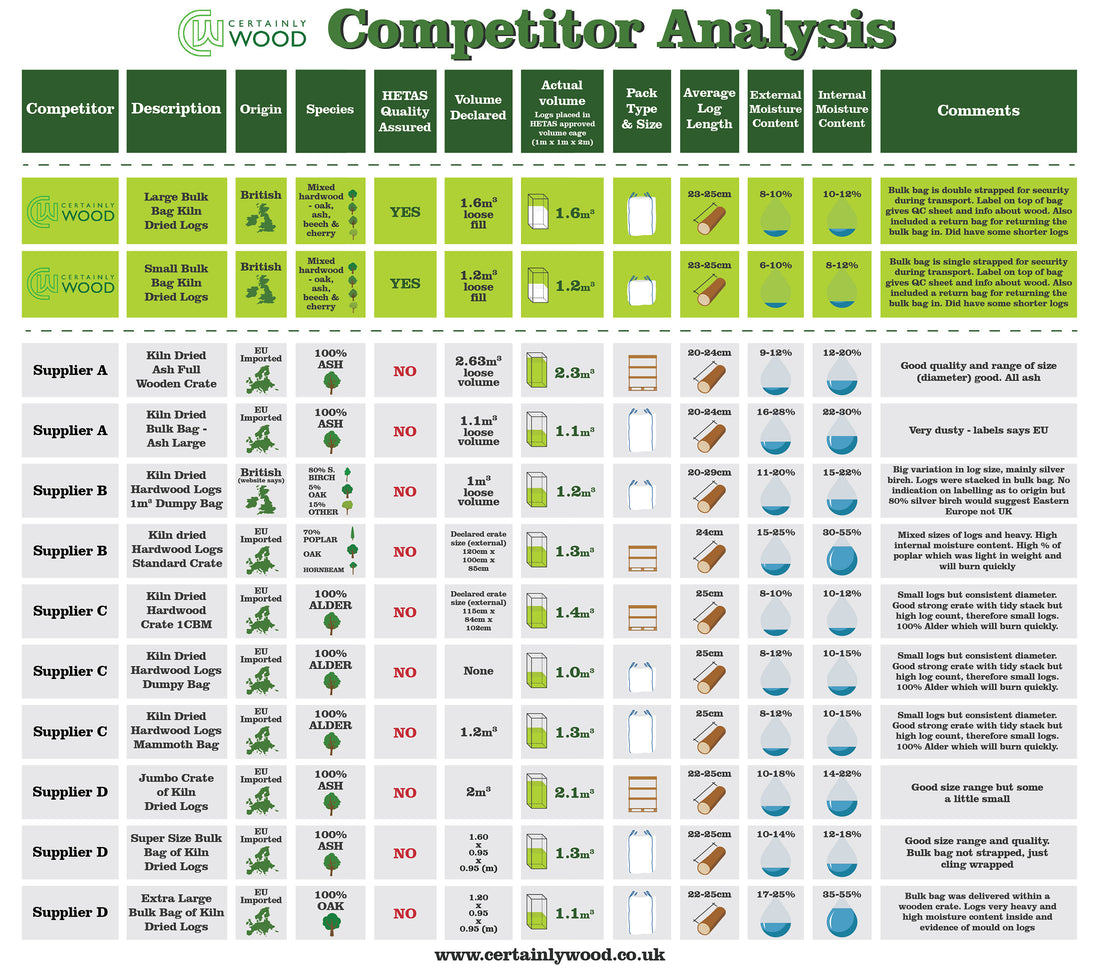
Compare the market
Share
It is a while since we updated our Competitor analysis page and the ability to compare firewood is certainly information that visitors to our site like to read. We have therefore carried out an in depth look at kiln dried logs online and the following infographic will hopefully help you to compare firewood and give you a better understanding of the market for kiln dried logs and the potential pitfalls when buying firewood. Following this is a useful guide to help in your buying decision and we have put together a number of questions you need to be asking a supplier.
Click the image below to enlarge

We think that you should be considering the following when making your purchase decision.
Where is the wood sourced from?
A very high proportion of kiln dried logs now come from Eastern Europe – countries such as Latvia and Lithuania. Are you comfortable about the provenance of timber from these countries or did the timber perhaps originate from perhaps Russia where sustainable forestry management is questionable?
These countries can also have more dominance of species such as Silver Birch and Alder. Although hardwoods, this firewood will burn much faster than species such as oak and beech and to a degree ash.
As a general rule if the wood is in a crate, or large unlabelled nets stating a volume in ‘litres’ then the firewood is almost guaranteed to be imported.
The final consideration for origin is, how far the kiln dried logs have travelled, hence the strong consideration for buying British.
If kiln dried, how were the logs dried?
To run kilns on oil or gas is not as eco-friendly as using wood fuel to run the kilns and perhaps solar panels to help produce renewable and sustainable electricity
How dry is the firewood?
Be very wary of the terms seasoned as it is not just about the length of time it has been stored, but how. Although you can tell visually how dry a log is by things such as weight, sound and visual cracks. The best measurement of moisture content is to use a moisture meter and measure both the external and internal (split surface) of a log to get a true average reading.
Whilst kiln dried logs are becoming known as the best logs to buy because they are known to provide a consistently dry firewood below 20% moisture content, just be cautious and do your research. With more and more kiln dried logs being produced in Europe and around the UK we are starting to see a significant variation in quality. More UK firewood producers are starting to use kilns and improving the quality of their firewood but there is far more to kiln drying logs than meets the eye. Believe us, we know from over ten year’s experience. The biggest problem is getting the wood dry enough to the centre of the log because if you don’t, the log just stops burning, blackens the glass and charcoals. So, don’t assume that all kiln dried logs are dry enough!
What species make up the offer?
If you are buying small quantities from your local garage, they will probably be in nets and invariably will be softwood such as pine or spruce. There is nothing wrong with softwood firewood as long as it is dry, but just remember it will burn almost twice as quickly as hardwood such as oak, ash and beech.
As mentioned earlier just be aware that silver birch and alder will burn in a similar way to softwood – perhaps mid-way between standard hardwood and softwood. If you take this route remember you will need to buy perhaps a 1/3 more volume of wood for the same heat output and oak or beech for example.
How much am I actually buying?
This is a real minefield and if you are not careful you might get caught out and not get as much as you think. Firstly always purchase by volume, but make sure you know whether it is ‘stacked’ or ‘loose’ volume. Generally crates are ‘Stacked’ and bulk bags are referred to ‘Loose Fill’. The HETAS volume approval system is based on tipping logs into a volume cage which is 1m x 1m at the base and a known height to calculate the volume of ‘loose fill’ in m3. Look at the following Infographic to see our findings on how much ‘loose volume’ (Actual volume column) comes from a small or large crate of logs. There are also varying sizes of crates coming in from Eastern Europe. Some suppliers over exaggerate the ‘loose volume’ equivalent making the price /m3 look much lower than it really is. We even found variations in crate size with most measurements based on the external rather than internal dimensions. This makes a surprising difference in final volumes.
Is there any sign of Quality Assurance?
Supply of firewood is a traditional industry and has never really had any control in terms of quality or standardisation and this is still predominantly the case although about eight years ago we worked with HETAS to develop a quality control system for firewood to provide standardisation and a quality ‘mark’ – Quality Assured Fuel. This is monitored by HETAS which is the equivalent of CORGI for the gas industry. HETAS provides certification for wood burning stoves, qualified installers and now wood fuel. This quality system is now being run by a company called Woodsure, but still overseen by HETAS. Look out for the HETAS or Woodsure certification logos that will appear on packaging or websites. This will provide you with the comfort and knowledge that wood fuel from these suppliers will have been tightly monitored through production not only to provide you with a consistent product below 25% moisture content but also supplied in a known and approved volume.
